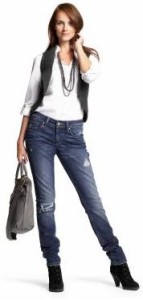Carolyn Braganca— ENG ’15
When average people think of rhetoric, they tend to think of words—either written or spoken. Students of rhetoric, though, know it extends beyond just words. However, how often do people consider the rhetorical nature of their appearance? After all, psychologists love to point out that much of what you communicate to others is communicated through non-verbal methods.
We live in a society that is very focused on appearance, and there are plenty of critics who support such a focus and there are those who heavily criticize it. While there are people who argue school dress codes should not shame girls who wear revealing outfits, there are also people who say boys should not be allowed to wear saggy pants. There are people who believe people should not judge others based on their weight, and there are people who say people should not be judged based on bodies at all.
For the record, I am indeed aware these criticisms have strong gender patterns. Although I do think the heavy criticism geared towards women is an important topic to discuss, I will not be doing so here—though I certainly encourage you to consider that pattern and comment below.
Whether you think it is fair or not, our appearance matters. Clothes are a basic necessity, so our consumer-based economy provides an outstanding selection of clothes to choose from. There is always a reason why people choose one outfit over another, and that choice is a rhetorical decision people make every day without fully realizing it. What you wear reveals something about you as a person and something about your mood.
Consider this woman—we’ll call her Rebecca, Becks for short. What are your immediate impressions of Becks based on this outfit? What does this outfit say about Becks’ personality? From what socioeconomic class would you guess she is, based on this outfit?
Why did she choose to wear jeans instead of leggings or sweatpants, and why are they boot-cut jeans instead of flair or skinny? Why did she opt for the black ankle boots instead of Converse or flats? Why a white shirt—why not another color? And why did she tuck the shirt in? Technically, all she needs is a shirt, so why did she add a vest? Why that color and style vest? And why long beads instead of nothing or something more subtle? Why did she style her hair like that—was she too lazy to put it up, or does she think it looks best while down? Why did she do her makeup like that—does she want to look like she isn’t wearing makeup?
Based on Becks’ outfit, what do you think she is doing? Is this what she wears to work? Is she going on a date? Is she simply running some errands? Is she passing a coffee shop at which she knows the person she likes will be?
In choosing that particular outfit, Becks is attempting to influence what others think about her. So what do you think?
How about this man—we’ll him Lucas, Luke for short. What are your immediate impressions of him? Why would you guess his personality is like? From what socioeconomic class does he look to be?
Why a bright blue suit instead of something more conventional like grey or black or even navy? Why does his jacket match his pants? Why are his pants a tight—does this indicate his age or his profession? Why isn’t his jacket buttoned? Why a white shirt—is he trying to balance an unconventional suit color with a more conventional shirt color? Why did he choose that tie instead of a skinnier one or one with a square bottom? Why did he use that knot? And why a navy tie—why not something more bright or interesting? Why the tie clip?
Based on Luke’s suit, what do you think he is doing? Is this a work outfit? What profession is in—banking, marketing, government? Is this what he wears to an average day in the office? Or is this something he would wear to meet clients? Or is Luke actually preparing to go on a date? How must he feel about his date if he dresses like this? Maybe it’s his anniversary and he booked a reservation at a high-end restaurant.
The point of this is not necessarily that it is okay to judge people based on how they dress. What people wear is a rhetorical decision that reveals something about the wearer—the operative word being something. The factors that go into deciding what to wear include not only your full personality—which influences which clothes you buy—but also your daily mood and context. While the former factor is relatively fixed, the latter two change frequently.
A single outfit is the tip of the iceberg that is who someone really is.
The main point is to make you consider how you dress and what this says about you. How do you represent yourself through your appearance? How does your appearance change based on your rhetorical context? You likely do not wear the same outfit to a job interview and a date or to a party with friends and a party with family. Why not? How do your outfits change, and what do these changes say about how you want others to perceive you?
How does your appearance represent who you are?



 Follow
Follow
One Comment
This is a great post that definitely made me stop and think twice about what rhetorical choices I am making with my own appearance. Before reading this, I would say that just throwing on random clothes in my closet doesn’t say much about me. However, even this choice can impact others’ perceptions of me. Though it would be fantastic people were free to express themselves through clothing without negative judgement, that’s simply not the world we live in. Much like in writing assignments, you should first assess your audience and purpose before planning how you want to present yourself.